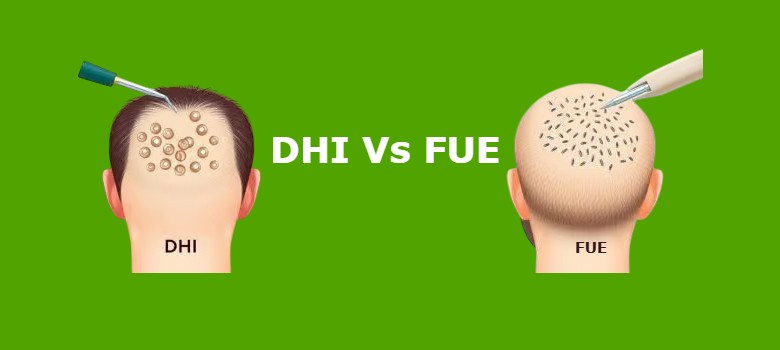Hair transplantation has revolutionized the way individuals address hair loss, offering permanent solutions to regain confidence and a full head of hair. Among the most popular methods are Direct Hair Implantation (DHI) and Follicular Unit Extraction (FUE). Each technique has its unique benefits and considerations, making it essential to understand their differences to determine which is the better option for you.
This article will explore the key aspects of DHI and FUE hair transplant techniques, including their processes, advantages, disadvantages, and suitability, helping you make an informed decision.
Understanding The Basics: What Are DHI And FUE?
Both DHI and FUE are advanced techniques that involve harvesting hair follicles from a donor area (usually the back or sides of the scalp) and implanting them into areas experiencing hair loss. Despite their similarities, they differ significantly in their approach, tools, and procedures.
1. What Is FUE Hair Transplant?
FUE (Follicular Unit Extraction) is a widely used hair transplantation technique where individual hair follicles are extracted from the donor area—typically the back or sides of the scalp—and implanted into the recipient area affected by hair loss.
How FUE Works:
- A surgeon extracts individual hair follicles using a micro-punch tool.
- The extracted follicles are preserved in a nutrient-rich solution to maintain viability.
- Small incisions are made in the recipient area, and the follicles are implanted.
Key Features:
- Minimally invasive procedure.
- Leaves tiny, dot-like scars that are hardly visible.
- Suitable for covering large balding areas.
2. What Is DHI Hair Transplant?
DHI (Direct Hair Implantation) is an advanced version of the FUE technique. It involves using a specialized tool, known as a Choi Implanter Pen, to simultaneously create incisions and implant hair follicles.
How DHI Works:
- Similar to FUE, individual hair follicles are extracted from the donor area.
- The follicles are loaded into the Choi Implanter Pen.
- The pen allows for precise implantation directly into the recipient area without creating pre-made incisions.
Key Features:
- Offers greater precision and control over implantation.
- Minimizes handling of hair follicles, improving survival rates.
- Suitable for achieving high-density results.
Comparing DHI And FUE: Key Differences
1. Technique And Tools
- FUE: Relies on manual extraction and separate incisions for implantation.
- DHI: Utilizes the Choi Implanter Pen, combining incision and implantation in one step.
2. Scarring
- FUE: Leaves micro scars that are virtually invisible.
- DHI: Produces even fewer scars due to the use of fine tools.
3. Hair Density
- FUE: Effective for covering larger areas but may achieve slightly lower density in smaller areas.
- DHI: Allows for higher precision, resulting in denser and more natural-looking outcomes, particularly in smaller target areas like the hairline.
4. Procedure Duration
- FUE: Can take 6-8 hours or more, depending on the number of grafts required.
- DHI: Typically longer because of the meticulous implantation process.
5. Cost
- FUE: Generally more affordable due to the simpler procedure and equipment.
- DHI: More expensive because of the advanced technology and precision involved.
6. Recovery Time
- FUE: Short recovery period, with visible results within a few months.
- DHI: Slightly quicker recovery due to less invasive techniques.
Advantages and Disadvantages DHI & FUE
FUE Hair Transplant
Advantages:
- Suitable for covering large balding areas.
- Minimal scarring.
- Cost-effective compared to DHI.
- Faster procedure compared to DHI.
Disadvantages:
- Slightly lower graft survival rate compared to DHI.
- Requires more skill and experience for optimal results.
- May not achieve high density in smaller areas like the hairline.
DHI Hair Transplant
Advantages:
- Higher precision and control during implantation.
- Achieves higher density and natural-looking results.
- Reduced handling of follicles improves graft survival rates.
- Ideal for creating defined hairlines and filling small areas.
Disadvantages:
- Longer procedure duration.
- More expensive than FUE.
- Not ideal for covering extensive bald areas.
Suitability: Which Is the Right Option For You?
Choose FUE If:
- You need to cover large balding areas.
- You are looking for a cost-effective solution.
- You want a quicker procedure and are okay with slightly lower precision.
Choose DHI If:
- You want highly precise and natural-looking results, especially for hairlines.
- You aim for maximum graft survival rates.
- You are willing to invest more time and money for advanced results.
- Your primary goal is achieving high-density implantation in smaller areas.
Factors to Consider Before Making a Decision
1. Extent Of Hair Loss:
- For extensive baldness, FUE might be a better option due to its ability to cover larger areas.
- For smaller or more localized hair loss, DHI is ideal for achieving a natural look.
2. Budget:
- If cost is a significant factor, FUE is more affordable.
- DHI may be worth the investment for those prioritizing precision and faster recovery.
3. Lifestyle:
- If you prefer not to shave your head, DHI is the better choice.
- For those comfortable with shaving, FUE remains a viable option.
4. Desired Results:
- DHI provides more control over hair direction and density, making it suitable for hairline restoration.
- FUE offers consistent results for larger-scale transplants.
5. Surgeon’s Expertise:
- The skill of the surgeon plays a critical role in the success of both techniques.
- Research clinics and surgeons thoroughly before making a decision.
Conclusion:
Both DHI and FUE hair transplant methods offer effective solutions for hair restoration, with their own set of benefits and limitations. The choice between them largely depends on your specific needs, including the extent of hair loss, budget, and desired results.
Consulting with a qualified hair transplant surgeon is crucial to determine the best option for your unique situation. Whether you opt for the precision of DHI or the versatility of FUE, a well-executed procedure can help you achieve a natural and confidence-boosting look.

